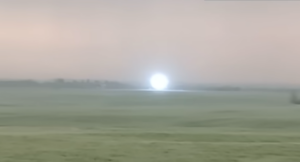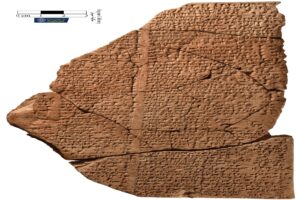For Yukon gold miner Travis Delawski, June 21 started like any other day — but it ended with the discovery of a lifetime.
As Delawski used heavy machinery to search for gold hidden in the Canadian tundra’s mud and permafrost, something incredible happened.
“I put the ripper into the wall, and popped it out, and I looked down and something was looking at me!” he said, causing laughter during an official government briefing. “I was like, ay!”
Less than a month later, a coalition of miners, First Nations leaders, paleontologists, and Canadian officials came together to tell the world: They had found a baby female woolly mammoth. Trʼondëk Hwëchʼin Elders named the mammoth calf Nun cho ga, meaning “big baby animal” in the Hän language.
Not just any mummified mammoth, either, but the most complete specimen ever discovered in North America.

Nun cho ga, the mummified baby woolly mammoth, with Chief Roberta Joseph, Minister Ranj Pillai, and Brian McCaughan of Treadstone Mining. Photo: Government of Yukon
A history of discovery
Much research remains to be done, but officials said preliminary examinations determined the mammoth calf died during the Ice Age, more than 30,000 years ago.
Nun cho ga was likely only 30-35 days old at the time of death and is about the same size as Lyuba, the 42,000-year-old baby mammoth found in Siberia in 2007.
The Yukon has a world-famous fossil record of Ice-Age animals. A partial mammoth calf, named Effie, surfaced in 1948 at a gold mine in interior Alaska. But it’s extremely rare to find mummified remains that still have skin and hair.
Recovery of the latest specimen required a group effort that started with the Treadstone Mining company, which immediately alerted Yukon government officials and the native government of the Trʼondëk Hwëchʼin (pronounced like this).

Wrapping up Nun cho ga following the ceremony with Trʼondëk Hwëchʼin, miners, scientists . Photo: Government of Yukon
‘A living being’
The First Nation’s leaders managed the discovery’s official briefing on July 13. They reportedly chose the animal’s name because the Hän language includes no word for “mammoth.”
Roberta Joseph, chief of the Trʼondëk Hwëchʼin, emphasized the discovery’s spiritual significance to a native culture that has lived in the Yukon for thousands of years.
“The discovery of Nun cho ga is about more than just science,” Chief Joseph said. “She is more than a historic specimen. She is one of our sacred ancestors. Nun cho ga was — and is — a living being.”
‘The most exciting scientific thing’
The University of Calgary also played an important role in safely removing the mammoth. Professor Dan Shugar, who helped with the excavation, couldn’t contain his excitement in a Twitter post.
“Being part of the recovery of Nun cho ga, the baby woolly mammoth found in the permafrost in the Klondike this week (on Solstice and Indigenous Peoples’ Day!), was the most exciting scientific thing I have ever been part of, bar none,” Shugar wrote.
Many of those involved expressed the same enthusiasm for being part of the mammoth’s story, including Yukon paleontologist Dr. Grant Zazula.
“As an ice age paleontologist, it has been one of my lifelong dreams to come face to face with a real woolly mammoth,” Zazula said. “That dream came true today. Nun cho ga is beautiful and one of the most incredible mummified Ice Age animals ever discovered.”
Scientists said the Nun cho ga could provide new insight into a bygone time when mammoths roamed the land alongside wild horses, cave lions, and giant steppe bison.






